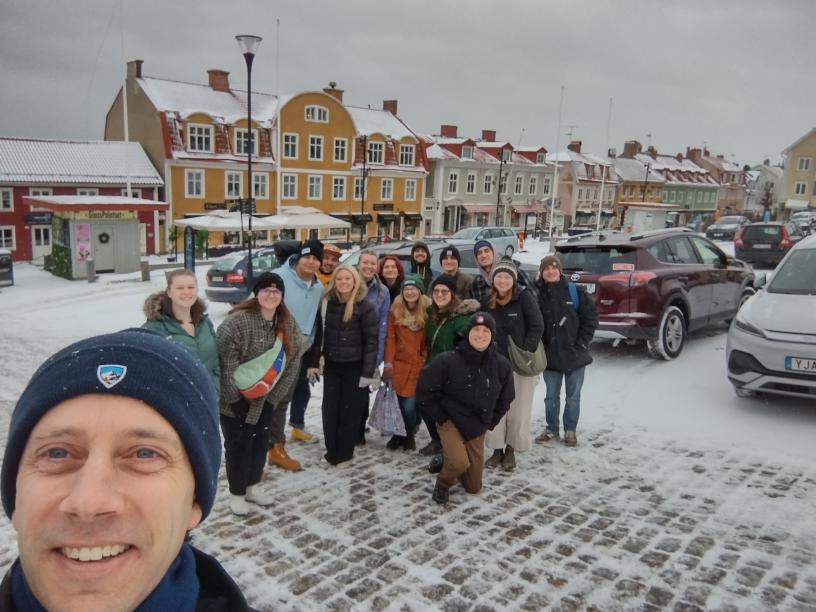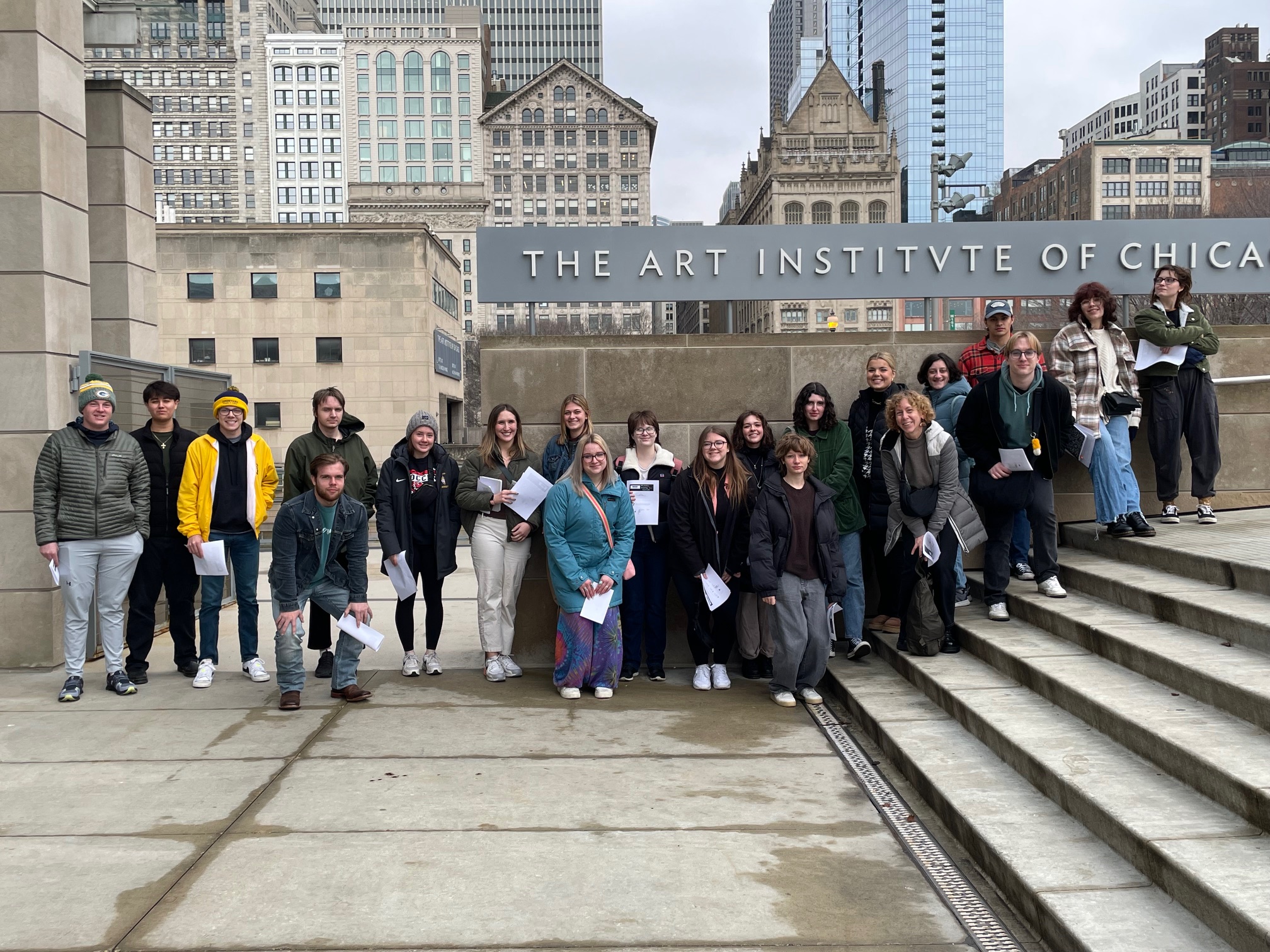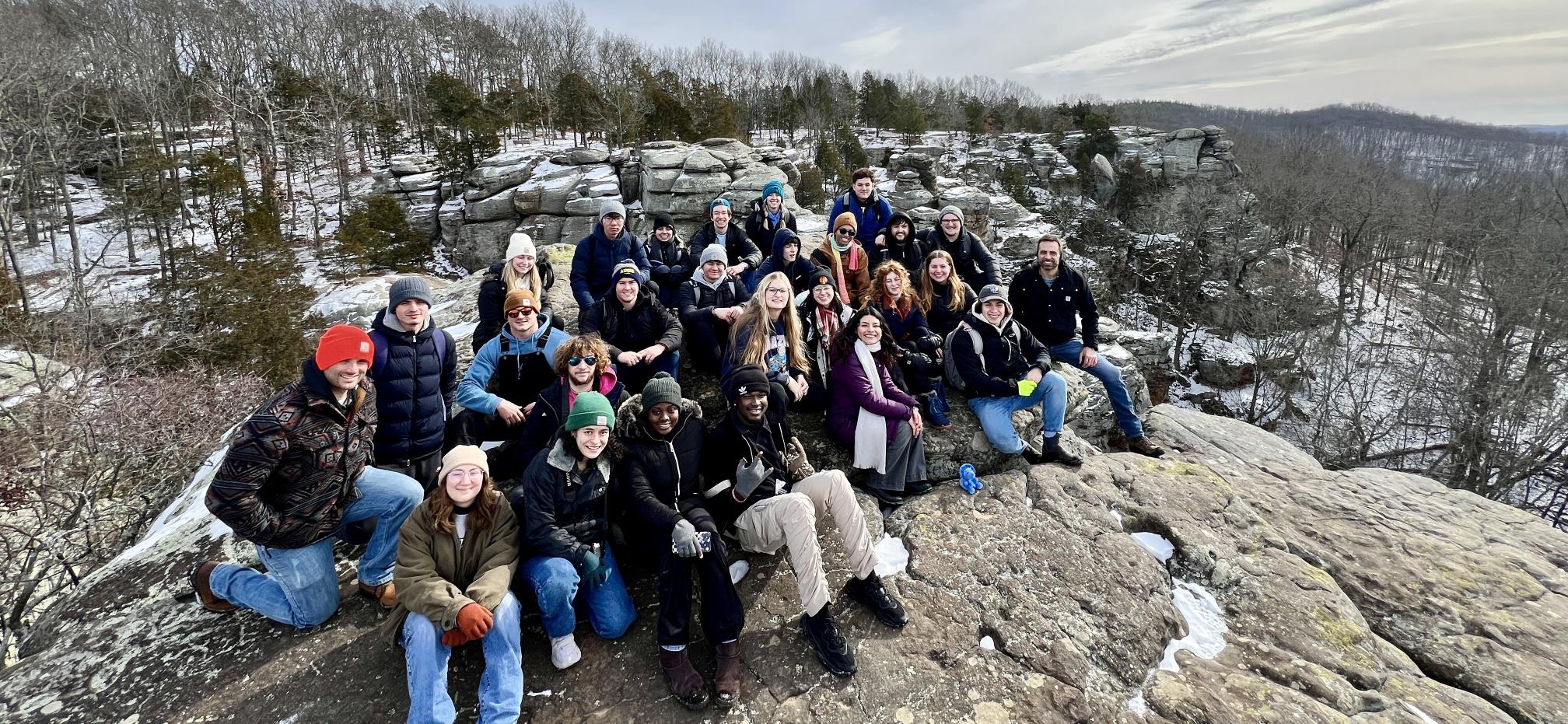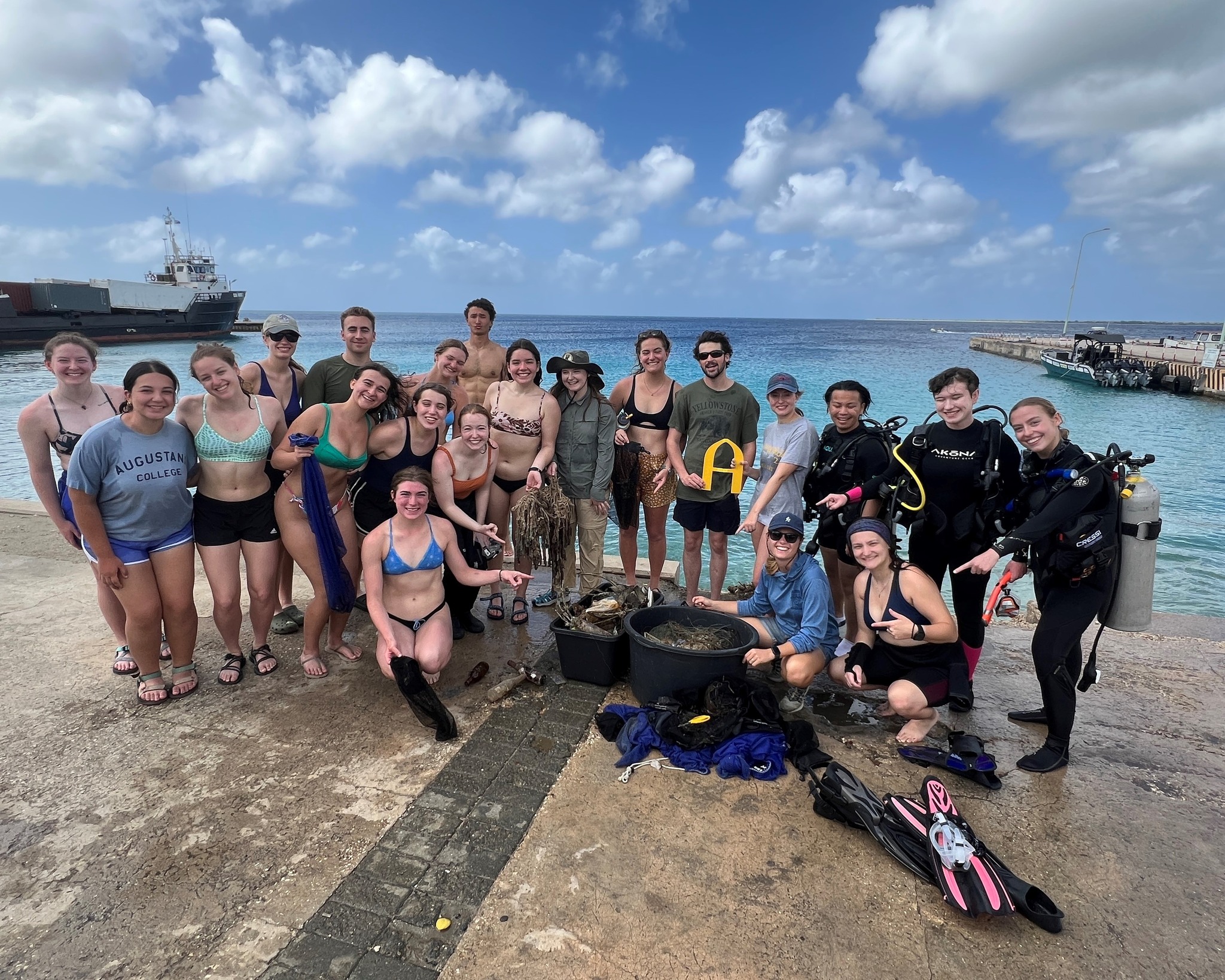Five years of Augustana’s January Term
Augustana College students take a break from their 15-week semester schedule to engage in a month-long period of intensive learning during January Term, or J-term. This three-and-a-half week course was added as part of the college’s transition to semesters in 2019-2020.
With each day dedicated to a single three-hour class, five days per week, students find themselves fully immersed in their chosen subjects, whether they opt for courses outside their major, indulge in in-depth explorations of specific topics or participate in short-term study away programs.
In Augustana’s fifth year of J-term, 1,990 students participated in this opportunity to deepen their knowledge and engage in transformative educational experiences. Here are some highlights:

Luca Barba ’24
Exploring silence and sonic meditations
In “Deep Listening” with Dr. Randall Hall, Luca Barba ’24, from Rockford, Ill., cultivated his mediation skills and explored religious and magical practices from around the globe. A philosophy major, Barba was excited to apply and expand his philosophical knowledge to a different discipline.
Each class opened and closed with meditation. During silent mediation at the beginning of class, students sat with closed eyes to practice aural awareness, the ability to perceive and understand sounds. The silent meditations lasted just 15 minutes at first, but eventually students were able to go past 105 minutes. Barba holds the course’s all-time record for silent meditation — 115 minutes!
Class ended each day with sonic meditation, which incorporates sounds like music, chanting or singing bowls as a central element of the practice.
Between mediation sessions, the class reviewed assigned readings and discussed culture from across the world and across time — from Greco-Roman mystics’ magical language, to shakuhachi flute playing from Japanese Zen monks, and ancient mesopotamia to indigenous Africa and Australia.
Barba left “Deep Listening” with a new love for sounds — and silence.
“One of the things that Dr. Hall makes us question in the course is our relationship with silence,” he said. “Silence is somewhat of a misleading term, as even in a perfectly silent room, one can still hear one’s own nervous and circulatory systems. So when I am in silence now, I can be aware and appreciate all the little sounds I do hear – a stovetop whirring, trees rustling, my clothes brushing against each other.”
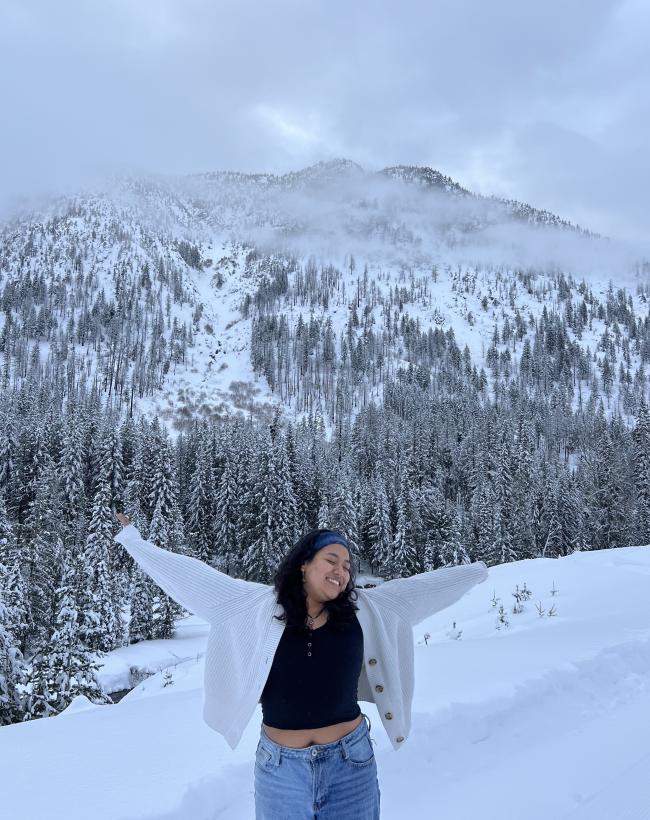
Adriana Reyes ’25
Exploring faith, nature and community
Adriana Reyes ’25, a geology major from Chicago, traveled to the American Northwest for “Creator, Creation & Calling” with Dr. Jason Mahn and Pastor Melinda Pupillo.
Holden Village outside of Chelan, Wash., allows students to step back from a fast pace of life. This remote spot in the Rocky Mountains serves as an intentional faith-based community thriving beyond modern conveniences like cell service and hot water.
The course looks at how God, nature and what people are meant to do all fit together. It explores how science, taking care of the environment, making personal promises and unique communities like Holden Village are all connected.
The class met in the morning to discuss the assigned book, excerpts of the Bible, vocation and the way theology and ecology integrate. In the afternoon, students headed to individual work assignments where they contributed to the community and met villagers.
One of Reyes’ favorite times of the day was “sacred space,” a prayer service held in the evening. “Every day the service was different,” she said. “It was unlike any other I’ve ever been to.”
Reyes and her classmates spent their free time taking hikes, going to the craft cave to take pottery and jewelry-making lessons, relaxing in the sauna, soaking in the snowy mountain scenery, and enjoying toasted Holden bread and a cup of hot chocolate.
For Reyes, staying in a slow-paced, remote environment made the experience truly special.
“It allows for a different perspective of joining a community and fully understanding how the village works. You form so many connections with students, faculty and villagers because of this unique setting.”
Gage Humphreys ’24
Debunking myths and embracing science
Gage Humphreys ’24, a business finance and accounting double major from Kingman, Ariz., took “Busting Myths” with Dr. Ray Harrison during J-term.
This course introduces students to experimental design and how findings can be communicated to the community using digital media. Throughout the term, students engage in experimentation to either validate or debunk a range of urban legends, societal perceptions and viral videos.
The day-to-day consisted of watching the hit show “MythBusters” and learning about the science behind each myth. Students would then brainstorm and hypothesize how the myth could be proven. Then it was on to conducting the experiment and creating a narrative to explain the findings.
Humphrey’s favorite experiences from the course? Being able to do an array of different lab activities and experiments.
“This was my first time in the science department and I can gladly say Professor Harrison was an amazing educator and went the extra mile to make the course fulfilling and fun!”
Briana Reagan ’25
Diving into geoscience
Briana Reagan ’25, from Poplar Grove, Ill., spent two weeks in Bonaire in the Caribbean Netherlands for “Island Geology” with Dr. Kelsey Arkle. For the geology and environmental studies double major, J-term was the perfect time to study abroad and use her Augie Choice while working toward her majors.
Before traveling to the island, the class spent a week on campus learning about the history of Bonaire, island formation and how to identify coral, fish and seagrass. Students were also able to get their scuba certifications on campus before the trip.
Once on the island, the class spent the morning and afternoon outdoors learning about sedimentation, weathering and erosion, tectonism, volcanism and coral reef formations. Fieldwork included going scuba diving, taking trips around the island and hiking to observe geological structures. In the evenings, the class met for nightly lectures and meetings to discuss the day’s observations.
Reagan’s favorite part of the course was scuba diving and seeing all the life underwater.
“We had a running competition to see who saw the most creatures,” Reagan said. “I think I ended up with almost 100, including seahorses, sea turtles and stingrays! One night we spent time on a beach during the low tide and we were able to see octopuses, crabs, eels and sea urchins.”
The class also learned about local environmental organizations, including Reef Renewal Bonaire and Sea Turtle Conservation Bonaire, and students had free nights where they got to explore the island, hang out on the beach or try local restaurants.
Reagan said that taking the Bonaire course was a fun and interactive way to dive deeper into geoscience. Plus, “Who wouldn’t want to spend their January in 85-degree weather and the sun?”
By Genevieve Ryan '26

